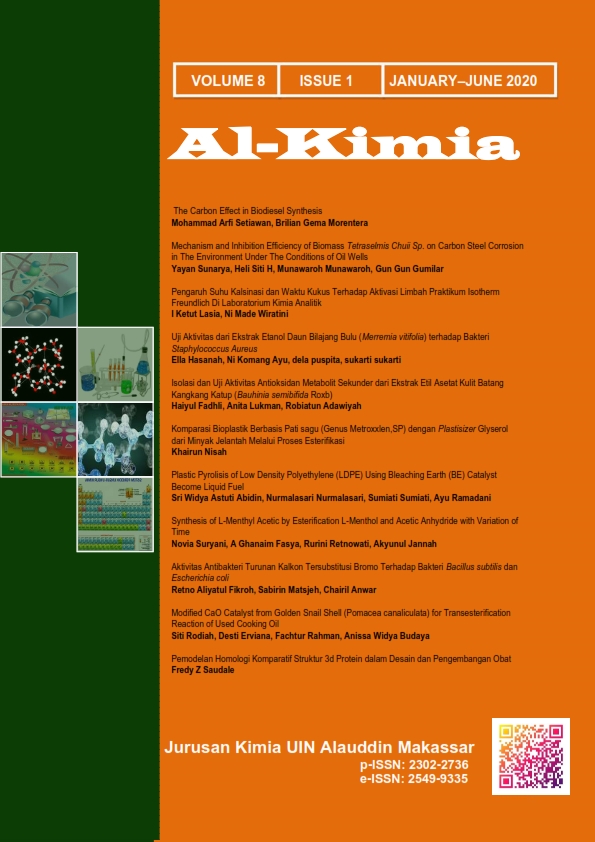The Carbon Effect in Biodiesel Synthesis
Abstract
Biodiesel is synthesized from the trans-esterification reaction of vegetable oil and alcohol using a catalyst such as acids, bases or enzymes. The acid catalyst that is often used is sulfuric acid; H2SO4, and HCl while most of base catalysts are NaOH and KOH. The aim of this study is to determine the effect of carbon derived from sugar heating in the synthesis of biodiesel with a sulfuric acid catalyst; H2SO4. Trans-esterification reaction of Jatropha oil and methanol with sulfuric acid catalyst was done with oil and methanol at 1:9 ratio. The results showed that (1) the physical properties of the biodiesel was synthesized with carbon-H2SO4 has a difference with physical properties the biodiesel was synthesized by sulfuric acid (2) carbon-H2SO4 was used in the trans-esterification reaction of Jatropha oil and methanol to produce methyl ester character is the density of 0.889 g / mL, 24.59 cSt viscosity and refractive index of 1.464, (3) methyl ester produced from the reaction of trans-esterification of Jatropha oil and methanol with sulfuric acid catalyst has a character that is a density of 0.882 g / mL, 11.70 cSt viscosity and refractive index of 1.458.
Downloads
References
Fukuda, H., Kondo, A. & Noda, H. (2001). Biodiesel Fuel Production by Transesterification of Oils. Journal of Bioscience and Bioengineering, 92 (5), 405-416.
Lotero, E., Liu, Lopez, D. E., Suwannakarn, K., Bruce, D. A., & Goowin, J. G. (2005). Synthesis of Biodiesel via Acid Catalysis. Ind. Eng. Chem. Res, 44, 5353-5363
Mohammed, I., Y., Abakr, Y., A., Kazi, F., K., Yusuf, S., Alshareef, I., & Chin, S., A. (2015). Pyrolysis of Napier Grass in a Fixed Bed Reactor: Effect of Operating Conditions on Product Yields and Characteristics. BioResources, 10(4), 6457-6478. DOI: 10.15376/biores.10.4.6457-6478.
Okamura, M., Takagaki, A., Toda, M., Kondo, J. N., Domen, K., Tatsumi, T., Hara, M., & Hayashi, S. (2006). Acid-Catalyzed Reaction on Flexible Polycyclic Aromatik Carbon in Amorphous Carbon. Chem. Mater, 18, 3030-3045.
Ramírez-Arias, A. M., Giraldo, L., & Moreno-Piraján, J. C. (2017). Biodiesel Synthesis: Use of Activated Carbon as Support of the Catalysts. Biorefining of Biomass to Biofuels, 117–152. doi:10.1007/978-3-319-67678-4_5
Sherbiny, S. A. E., Refaat, A. A., Sheltawy, S. T. E. (2010). Production of biodiesel using the microwave technique. Journal of Advanced Research, 1(4): 309-314. DOI: doi.org/10.1016/j.jare.2010.07.003
Subhedar, P. B., & Gogate, P. R. (2016). Ultrasound assisted intensification of biodiesel production using enzymatic interesterification. J. Ultsonch, 29: 67-75. DOI: 10.1016/j.ultsonch.2015.09.006
Toda, M., Takagaki, A., Okamura, M., Kondo, J. N., Hayashi, S., Domen, K. & Hara, M. (2005). Biodiesel Made with Sugar Catalyst. Nature, 438.
Vasudevan, P. T & Briggs, M. (2008). Biodiesel Production Current State of the Art and Challenges. J Ind Microbiol Biotechnol, 35, 421-430.
Zong Min-Hua, Duan Zhang-Qun, Lou Wen-You, Smith, T. J. & Wu, H. (2007). Preparation of a Sugar Catalyst and Its Use for Highly Efficient Production of Biodiesel. Green Chem, 9, 434-437.
Copyright (c) 2020 Mohammad Arfi Setiawan

This work is licensed under a Creative Commons Attribution-NonCommercial-ShareAlike 4.0 International License.
Authors who publish with this journal agree to the following terms:
1) Authors retain copyright and grant the journal right of first publication with the work simultaneously licensed under a Creative Commons Attribution License that allows others to share the work with an acknowledgement of the work's authorship and initial publication in this journal.
2) Authors are able to enter into separate, additional contractual arrangements for the non-exclusive distribution of the journal's published version of the work (e.g., post it to an institutional repository or publish it in a book), with an acknowledgement of its initial publication in this journal.
3)Authors are permitted and encouraged to post their work online (e.g., in institutional repositories or on their website) prior to and during the submission process, as it can lead to productive exchanges, as well as earlier and greater citation of published work (See The Effect of Open Access).


